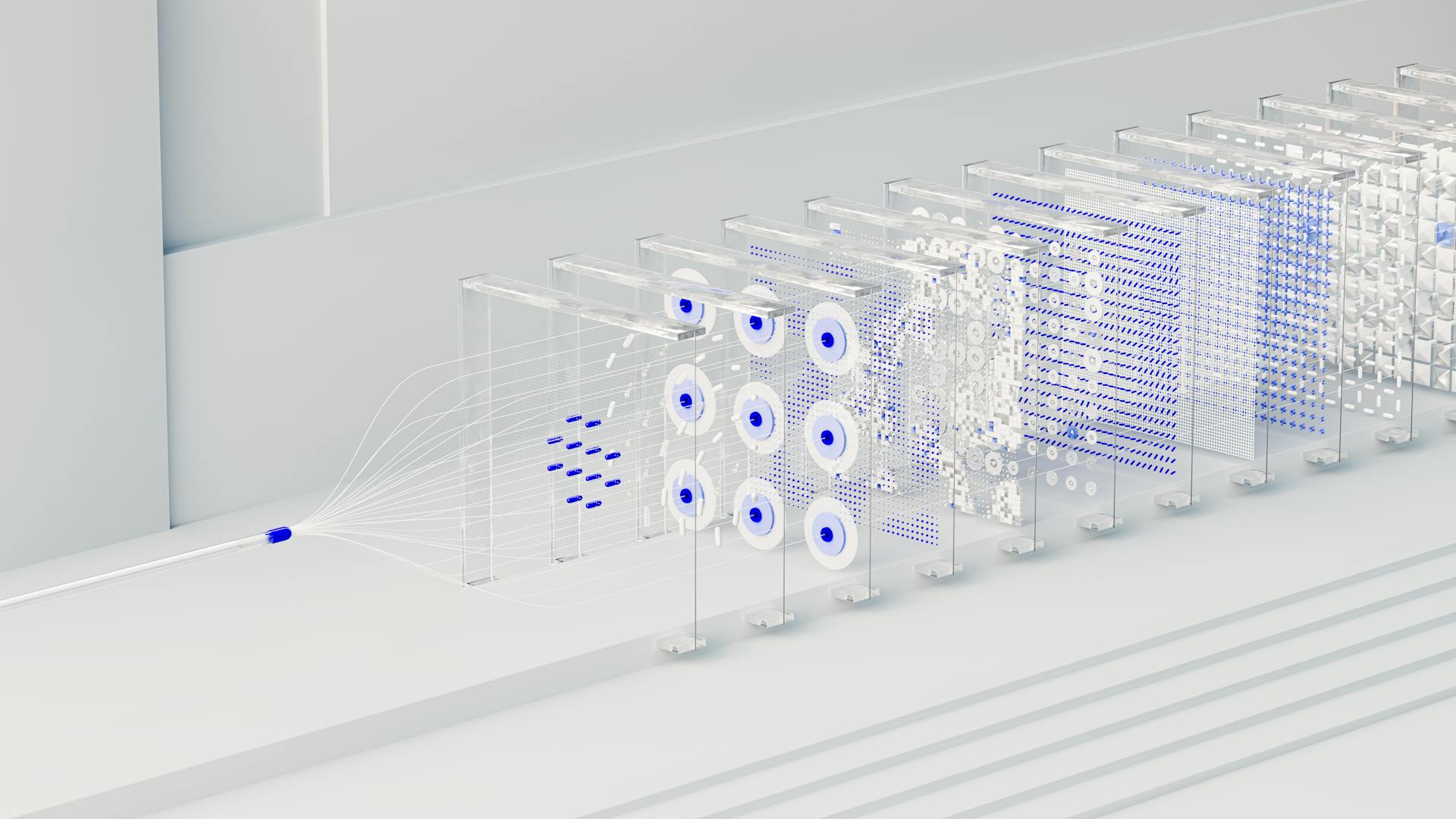
Adversarial examples are a type of threat to AI systems that can have serious consequences.
These examples are specifically designed to deceive machine learning models, causing them to make incorrect predictions or take unintended actions.
In some cases, adversarial examples can be crafted to be undetectable by humans, making it difficult to identify and mitigate the threat.
Adversarial examples can be used to compromise the security of AI systems, allowing attackers to gain unauthorized access or manipulate sensitive information.
To safeguard against these threats, researchers have developed various measures, including the use of regularization techniques and adversarial training.
These measures can help to improve the robustness of AI models and reduce their susceptibility to adversarial examples.
Related reading: Towards Deep Learning Models Resistant to Adversarial Attacks
Generating Methods
Generating Methods for Adversarial Examples are crucial in understanding how these modified inputs are crafted to deceive Machine Learning models.
One of the earliest methods proposed was the use of a single iteration to generate adversarial examples, as mentioned in Goodfellow et al. (2014).
Researchers have since reduced the adversarial example searching problem to an optimization problem with an objective function defined for malicious purposes.
The optimization problem can be solved using a gradient optimizer, and after minimizing the objective function, the example can be regarded as adversarial if the loss falls below a given threshold.
Researchers have also developed various methods to generate adversarial examples without the help of gradient optimizers, such as Su et al. (2017).
The state-of-the-art adversarial example generating method is C&W's Carlini and Wagner (2017b), which has been widely used in the field.
Discover more: Which Is an Example Limitation of Generative Ai Interfaces
Types of
Adversarial attacks can be categorized into two main types: White Box and Black Box attacks. If an attacker has access to the underlying model parameters and architecture, it's called a White Box Attack, which is not very common.
There are also untargeted and targeted adversarial attacks. Untargeted attacks just want the model to be confused and predict a wrong class, while targeted attacks compel the model to predict a specific wrong output.
A different take: Adversarial Ai Attacks

A Black Box Attack, on the other hand, occurs when the attacker has no access to the deployed model architecture, making it a more common and worrying scenario.
Here's a breakdown of the types of adversarial attacks:
It's worth noting that an adversarial example created for one machine learning model is usually misclassified by other models too, even when the other models had different architectures or were trained on a different dataset. This means that an attacker can create an adversarial example for one model and it will likely break most other machine learning systems as well.
A unique perspective: Supervised or Unsupervised Machine Learning Examples
Basic Iterative Method
The Basic Iterative Method is a clever way to generate adversarial images. It involves applying a perturbation multiple times with a small step size.
To do this, the pixel values of intermediate results are clipped after each step to ensure they're within a certain range of the original image. This range is defined as [Xi,j−?,Xi,j+?], where Xi,j is the pixel value of the previous image.
This method is useful because it helps to prevent the image from becoming too distorted. By applying the perturbation in small steps, we can control the amount of change that occurs with each iteration.
The equation for generating perturbed images using this method is given by the code snippet:
defstep_targeted_attack(x,eps,one_hot_target_class,logits):
cross_entropy=tf.losses.softmax_cross_entropy(one_hot_target_class,logits,label_smoothing=0.1,weights=1.0)
x_adv=x-eps*tf.sign(tf.gradients(cross_entropy,x)[0])
x_adv=tf.clip_by_value(x_adv,-1.0,1.0)
returntf.stop_gradient(x_adv)
This code snippet shows how the perturbation is applied in small steps, with the pixel values clipped after each step to ensure they're within the desired range.
Related reading: Hidden Layers in Neural Networks Code Examples Tensorflow
Safeguarding Against
To prevent our models from being attacked by adversarial examples, one effective technique is to use these examples for training. This way, our network learns to avoid them.
Adversarial training is a type of proactive defense where the model is trained on adversarial examples to improve its robustness. This is in contrast to reactive defenses, which involve detecting and mitigating attacks after they have occurred.
There are several methods to generate adversarial examples, including the Fast Gradient Sign Method, Basic Iterative Method, and Jacobian-based Saliency Map Method. These methods can be used to create a large number of adversarial examples for training.
You might like: Generative Adversarial Networks Training
Some popular methods to generate adversarial examples include:
- Fast Gradient Sign Method – Goodfellow et al. (2015)
- Basic Iterative Method – Kurakin et al. (2016)
- Jacobian-based Saliency Map Method – Papernot et al. (2016)
- Carlini Wagner L2 – Carlini and Wagner(2016)
- DeepFool – Moosavi-Dezfooli et al. (2015)
- Elastic Net Method – Chen et al. (2017)
- Feature Adversaries – Sabour et al. (2016)
- LBFGS – Szegedy et al. (2013)
- Projected Gradient Descent – Madry et al. (2017)
- The Momentum Iterative Method – Dong et al. (2017)
- SPSA – Uesato et al. (2018)
- Virtual Adversarial Method – Miyato et al. (2016)
- Single Pixel attack.
In addition to adversarial training, another technique to prevent adversarial attacks is defensive distillation. This method can be used in conjunction with other defense mechanisms to provide even greater protection against attacks.
Threat Models
Adversarial examples generated by certain methods cannot be directly used to attack real-world systems because of their different threat models.
In theoretical adversarial example attacks, the input of the model is directly exposed to attackers. This is not the case in practical attack scenarios, where the system using the model exposes its capture interfaces to attackers, making it harder for them to inject input data.
Attackers in practical scenarios face even more challenges, such as the system imposing detection modules between the model and the front-end input camera to detect potential attacks. For instance, in a face authentication system, there exists liveness detection modules to examine if the object in front of the camera is a live human being or a printed photo.
For your interest: Adversarial Attack
Attack Threat Model
In practical adversarial example attacks, the threat model is more restricted than in theoretical attacks. The input of the model is not directly exposed to attackers, but rather, the system using the model exposes its capture interfaces to attackers.
Attackers can only manipulate the object in front of the camera, such as a dog, and cannot directly inject input data into the model. Their goal remains the same: to trick the system into outputting a target chosen by the attacker, like a cat.
In this scenario, attackers face even more challenges, including detection modules between the model and the front-end input camera that can detect potential attacks. For example, in a face authentication system, there are liveness detection modules to examine if the object in front of the camera is a live human being or a printed photo.
To bypass these mechanisms, attackers usually place an object that can pass the detection and then apply small perturbations that won't fail the front-end examinations. They may also assume a white box setting, where the model structure and weights are known to attackers, and come up with a supporting black box extension to ease the assumption.
See what others are reading: Grid Search Python
Poisoning
Poisoning attacks can be particularly insidious because they involve modifying the training data to bias a model towards a specific outcome.
This can be done by adding malicious data to the training set, as seen in poisoning attacks where the model is biased towards a specific classification.
An attacker could manipulate the training data to make the model more likely to misclassify certain inputs, which can have serious consequences in real-world applications.
For instance, in the case of a self-driving car, poisoning attacks could cause the model to misclassify a pedestrian as a parked car, leading to a serious accident.
Discover more: Ai Security Training
Attack Procedures
To design a practical adversarial example attack, an attacker should first design a perturbation mounting scheme. This can be as simple as printing perturbations on stickers and pasting them on the attacking object.
The attacker can also use a projector to project perturbations on the object. This method allows for more flexibility and precision in implementing the perturbation.
To construct a loss function, the attacker needs to measure the implementability of the perturbation under each restriction. This is done by adding penalty functions to the loss function, which weights the difficulty of implementing the perturbation.
The loss function is represented by the equation: $$ {\underset{r}{\arg\min}} J(x+r,y) + \sum_{i} {Penalty}_{i}(r) $$
The attacker can then choose an attacking object x and a target y, and run a gradient optimizer to work out a perturbation r.
Attack Procedures
To design a practical adversarial example attack, you need to start by creating a perturbation mounting scheme. This can be as simple as printing perturbations on stickers and pasting them on the attacking object.
The attacker can also use a projector to project perturbations on the attacking object. This method allows for more flexibility and creativity in designing the perturbation.
Once you have your perturbation mounting scheme, you need to construct a loss function that fools the target model while measuring the implementability of the perturbation. This is done by minimizing the loss between the adversarial example and the target, while also considering the difficulty of implementing the perturbation.

The loss function is represented by the equation: $${\underset{r}{\arg\min}} J(x+r,y) + \sum_{i} {Penalty}_{i}(r)$$
Where $J$ represents the loss between the adversarial example and the target, and each penalty function weights the difficulty of implementing the perturbation under each restriction.
Here are the steps to follow in designing a practical adversarial example attack:
- Design a perturbation mounting scheme using stickers or a projector.
- Construct a loss function that fools the target model while measuring the implementability of the perturbation.
- Choose an attacking object and target, and run a gradient optimizer to work out a perturbation.
- Print the solved perturbation using your mounting method and start to attack the system.
By following these steps, you can design a practical adversarial example attack that effectively fools the target model.
Black Box
In a black box attack, the attacker has limited access to the model's internal workings.
The attacker can only query the model with images as input and get the result returned, making it harder to understand how the model is making its predictions.
Even with limited access, the attacker still needs to work out a perturbation for the target, such that the model outputs the target, as shown in the case of Bhagoji et al. (2017).
This type of attack requires the attacker to be clever and find ways to manipulate the input to get the desired output from the model.
Attack Restrictions

In practical scenarios, attackers face restrictions that aren't considered in theoretical adversarial example cases.
One issue attackers must pay attention to is how perturbations can be presented on the attacking object. They can't overlay arbitrary colors on the object in the real world.
Attackers can't directly borrow adversarial example generating methods that don't limit the color of perturbations for practical attacks.
In practical scenarios, systems often impose detection modules between the model and the front-end input camera to detect potential attacks.
Frequently Asked Questions
What is an adversarial example?
An adversarial example is a modified image that is designed to trick a machine learning model into misclassifying it. This is achieved by applying a small, subtle perturbation to a clean image that the model originally classified correctly.
What are the causes of adversarial examples?
Adversarial examples are caused by model linearity, one-sum constraint, and the geometry of categories, making them vulnerable to manipulation. Understanding these causes is key to developing more robust AI models.
Sources
- https://paperswithcode.com/task/adversarial-attack
- https://www.mathworks.com/help/deeplearning/ug/generate-adversarial-examples.html
- https://www.nightfall.ai/ai-security-101/adversarial-attacks-and-perturbations
- https://cybersecurity.springeropen.com/articles/10.1186/s42400-018-0012-9
- https://cv-tricks.com/how-to/breaking-deep-learning-with-adversarial-examples-using-tensorflow/
Featured Images: pexels.com


